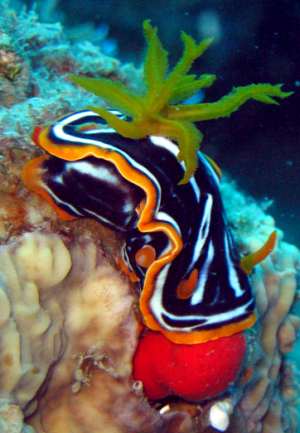Re: 'Pyjama slugs' from the Red Sea
October 10, 2005
From: Matan Ninio

Dear Bill,
Here is another example of this "Chromodoris africana " color form, again from Eilat. This time it's got it's head deep in a red sponge.
Locality: Shirat Hayam Kenion, Dekel beach, Eilat. Israel. Red Sea. Depth: 23 m. Length: 50 mm. 9 October 2005. Photographer: Oded Bar-Lev
Matan Ninio
matan@forumhasofiot.yam.dive.ninio.org
Ninio, M, 2005 (Oct 10) Re: 'Pyjama slugs' from the Red Sea. [Message in] Sea Slug Forum. Australian Museum, Sydney. Available from http://www.seaslugforum.net/find/14975Dear Matan,
This is a nice find. Although I am not a great believer in common names, 'Pyjama slugs' is certainly a nice way of labelling this colour group. This animal is almost certainly the same as the lower left photo in Ilan Ben Tov's earlier message [#9457] from the Red Sea. If colour patterns mean anything then I think I have to identify this asChromodoris kuiteri . Certainly Ilan's animal looked identical to eastern Australian specimens, and although the white lines in your animal are a bit irregular, it is the only species of this colour group in which there is black pigmentation on the inside edge of the orange mantle border.
Finding it on this red sponge is also exciting because it is almost certainly the same red sponge that C. quadricolor is usually found on. I have a record on the Forum [#1404] of this species feeding on Dysidea, but this could be wrong as it was based solely on the a photo that accompanied the specimen.
I could of course be quite wrong in thinking this is C. kuiteri, and this may be a strange colour form of C. quadricolor, but I suspect the best way to find out is for local observers like you, to keep an eye on these 'Pyjama slugs' and see if you can find some biological differences. It would be wonderful if you could find different colour 'forms' laying eggs - either the same or different, or mating etc etc. Perhaps you can notice a different shape of the body. For instance, in C. quadricolor and C hamiltoni, the mantle skirt down each side of the body is quite narrow compared to the relatively wide and thin skirt of C. africana. What we have here is almost certainly a case of mimicry, much like the red-spotted species I describe from southeastern Australia. This mimicry has evolved to survive predation, but although out brains are better than fishes, it is sometimes difficult, even for us, to separate one species from another on external colour patterns.
Best wishes,
Bill Rudman
Related messages
-
Re: 'Pyjama slugs' from the Red Sea
From: Kamal El Tawil, October 19, 2005 -
Could this be Chromodoris africana?
From: Gary Cobb, November 13, 2003 -
Chromodoris kuiteri laying its spawn
From: Julie Marshall, April 11, 2003 -
Chromodoris kuiteri from Lord Howe Island
From: W.B. Rudman, January 25, 2003 -
Chromodoris kuiteri from nthn New South Wales
From: A. Lumnitzer, June 12, 2000 -
Food of Chromodoris kuiteri
From: Bill Rudman, October 7, 1999 -
Chromodoris kuiteri from Heron Island
From: Nerida Wilson, June 27, 1999 -
re: Food for Chromodoris kuiteri
From: Nerida Wilson, December 7, 1998 -
Food for Chromodoris kuiteri
From: Nerida Wilson, November 27, 1998 -
A Chromodoris from Mooloolaba
From: Wayne Ellis, June 22, 1998
